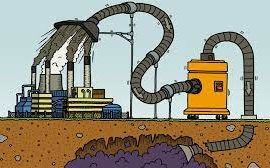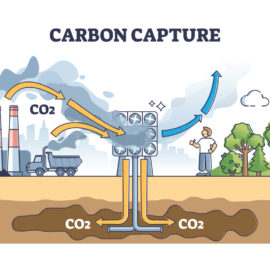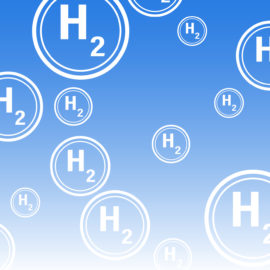
Not loved by all, some in Parishes that want carbon capture are saying no.
When two companies planning carbon capture projects appeared before the Livingston Parish Council this week, residents overcrowded the parking lot and packed shoulder to shoulder into the hearing room to speak out against them. The council had already voted to block not just those plans, which would pump carbon into the ground near Holden and under Lake Maurepas, but all injection wells for a year. Yet residents still showed up in force, accusing some leaders of keeping the projects quiet and siding with big companies instead of their constituents. “The project is moving way too fast. They run in here with the big money talk, bully, bully, bully our communities,” Kinion Bankston, a North Albany resident told state representatives. “Help us stop this, man. We love that lake. We absolutely love that lake.” The audience, which had cheered and yelled throughout his speech, erupted in applause.
nola.com
three different parishes have citizens riled up and just saying no.
It wasn’t just Livingston. In St. Helena and Tangipahoa Parishes, residents turned up in droves this past week to demand parish leaders block injection wells in their parishes. At issue is a process of capturing the carbon created in industrial processes and pumping it deep underground instead of emitting it into the air. Industry experts laud the practice as a way to fight climate change in a world still reliant on oil and gas. But environmentalists — and now many residents in the Florida parishes — fear the process will harm their vibrant wildlife, the local economy and personal safety. “It’s all tied to the oil and gas industry. It’s not that we’re against that,” said Eric Harrell, another Livingston Parish resident who lives in the Holden area. “This is kind of a new technology that hasn’t been widely done. There’s been failures in other parts of the country. We basically don’t want that.”
The number of sites desired by companies may be part of the out roar. They are everywhere!
Two projects are on the horizon for carbon capture in the region: A facility near Holden in Livingston Parish by Oxy Low Carbon Ventures and a “blue hydrogen” manufacturing plant near Burnside in Ascension Parish by Air Products. Oxy Low Carbon Ventures, a subsidiary of Occidental Petroleum, has leased 300,000 acres of land from Weyerhaeuser and filed a permit with the U.S. Environmental Protection Agency to build injection wells in hopes of opening its facility by 2025. Air Products’ $4.5-billion plant would capture, compress and liquify its carbon emissions before carrying it 37 miles via pipeline and injecting it about a mile below Lake Maurepas, which touches Livingston, Tangipahoa, St. James and St. John the Baptist parishes. Air Products will begin a six-month seismographic survey next month as part of the permitting process, which will involve detonating five pounds of dynamite in various spots 60 feet below the lake’s bottom. The company says the survey will “leave no permanent impact to the lake.”
The company says all is well and this is a perfect spot.
The company cited several reasons why Lake Maurepas was the best location for their project during a presentation at a Tangipahoa Parish council meeting: The lake contained very few pre-existing oil and gas wells, minimized pipe length, didn’t require crossing the Mississippi River and had optimal geographic conditions for wells. But residents who live near the site are worried. About 75 Tangipahoa Parish residents flocked to the parish council meeting Monday night for public input on the matter, where they voiced concerns about the economic and environmental vitality of Lake Maurepas should the seismographic survey and injection wells be carried out. “Lake Maurepas has great value as an economic engine for Southeast Louisiana,” said John Hoover, a fisherman and member of The Pontchartrain Blue Crab Association. “Have we not learned from the mistakes of the past by leveeing the Mississippi River, cutting 1,000-year-old Cypress trees that caused coastal crisis? Carbon capture has more risk than gains for Lake Maurepas.” Hoover added that Lake Maurepas is home to blue crabs, rangia clams, catfish, manatees and sturgeon that maintain the local ecosystem and provide a source of food and business for locals. Residents feel they have been left in the dust by state officials, who they believe approved the projects without sufficiently consulting local governments or residents. “I don’t know what the options are that we have — we don’t have many,” Tangipahoa District Four Councilman Carlo Bruno said at the parish council meeting. “This thing is like a train that’s already on the track.”
Yes to all your arguments but trust me, we can do it well.
Oxy Low Carbon Ventures, the company building near Holden, says on their project website that the Livingston hub will play a key role in helping reduce carbon emissions and generate tax revenue for the region. The company will also follow industry best practices when it comes to safety, the website says. “We have been and will continue to engage with the council members and the broader community to ensure they have information and an opportunity to provide feedback and ask questions,” said Doug Conquest, vice president with the company. “Our intention is to be a good long-term neighbor and partner in Livingston Parish. These include plans to properly manage our construction and operation activities and listen to and respond to any concerns.” At the Livingston meeting, Thomas Harris, secretary of the Department of Natural Resources, said many of residents’ fears were rooted in misinformation about carbon capture technology floating around on social media. “You can be for it, you can be against it, and that’s your right,” he said. “But one thing that’s not accurate: it’s not new technology. We’ve been drilling wells for 100 years here in Louisiana, we’ve been doing injections for over 40. And we’re good at it. We can do it well. We can do it properly. We can do it with full oversight. And we can do it in a manner that is protective of human health and the environment.” Various agencies have oversight over the projects, he added — meaning there are more officials to ensure companies adhere to strict regulations at every step of the process. “There was years and years where there was no regulation whatsoever. I’ve seen the mess. I’ve cleaned them up,” he said. “One of the lessons I’ve learned is how important it is to do things right and with excellence from the beginning.”
You paint a pretty picture but look at history and all the problems. Not that rosy.
Worried residents have a worst-case scenario in mind: a repetition of the catastrophic carbon dioxide pipeline rupture in Statartia, Mississippi in 2020. The breach hospitalized 49 people and forced about another 300 to evacuate. Brian Snyder, an associate professor at LSU’s Department of Environmental Sciences, said the incident shows where the primary risks of carbon capture are: Not the injection wells themselves, but the pipelines that carry carbon to them. “The risk in storage, the risk in leakage is really low,” he said “It’s not going to be the sort of thing that kills people or causes a sinkhole.” Instead, he said, the danger lies in the transport. “When you transport carbon dioxide, you do it at a pretty high pressure in a super critical state,” he said. “The problem with transport is you’re moving a lot of it all at once. You really need to make sure there’s not a catastrophic failure in the pipeline.”
There are regulations and shut off valves and we have seen this before and know what can go wrong.
To mitigate that risk, Snyder noted companies should follow regulations, increase the number of “shut-off valves” spaced along a pipeline and consider building pipelines away from populated areas like neighborhoods or schools. And he understands why people are anxious. “The oil and gas industry has not done everything perfectly in this state or this country over the last 50 years,” Snyder said. “When they come in and say, ‘Hey we’ve got this new technology that’s going to be great,’ people are sort of rightly skeptical. It’s probably a healthy skepticism, a healthy attitude to have. It’s just in this case, the facts don’t support this skepticism.” A federal agency overseeing pipeline safety concluded the Statartia rupture was caused by persistent heavy rain and negligence by the company in charge when it came to preparing for hazards and notifying the public, according to a report from Mississippi Today. Clay Spencer, the project manager for the Lake Maurepas pipeline, told Tangipahoa’s council that if there was leakage, it wouldn’t stay below the water’s surface and wouldn’t affect anyone above the water’s surface. He added that their project is much safer since there isn’t hydrogen sulfide in the area. And he said the company will have a continuous public awareness program with meetings in every parish the company operates in, which will be separate from the ongoing public meetings in Livingston. Conquest, the vice president with Oxy, said their project will have “comprehensive monitoring for the surface and subsurface activities,” and that the company will develop an EPA-approved carbon sequestration monitoring, reporting and verification plan for safety. But Cynthia J. Ebinger, a Tulane University professor in the Department of Earth and Environmental Sciences, has her concerns because the companies will “be increasing pressure in the subsurface when they’re putting these fluids in.” Leakage, she added, is inevitable. “We’re at the forefront of climate change, so we have to be alert,” she said.
There are too many variables.
Environmental activists say carbon capture sequestration is costly and unproven at scale. Logan Atkinson Burke, executive director of the Alliance for Affordable Energy, is frustrated that there is not more investment in proven, clean technologies, such as solar and wind power. With carbon capture, there are too many unknowns that could ultimately negate the purported benefits of the technology, she argued. She said the world already knows how to meet climate goals: reduce demand, use energy efficiently and transition to cheap renewables. “It’s as if those things, which are sure bets, are being ignored in favor of a unicorn,” she said. “I deeply hope that Louisiana decision makers listen to communities saying they don’t want something in their neighborhood.”
These are not done deals yet so the comments should have some effect.
The carbon capture injection wells aren’t a done deal just yet though — Air Products have several permits to still get from several different agencies on state and federal levels. At the parish level, officials say moratoriums like the one Livingston imposed are their only tool to prevent these carbon capture and sequestration projects from moving forward. But even then, it’s up in the air whether a parish moratorium can prevent injection wells from being constructed in Lake Maurepas, a state-owned water body. “The Parish isn’t just sitting on their hands not doing anything about this,” said Brad Cascio, an attorney for Tangipahoa. “If there was something we could do about it, like a moratorium or an ordinance to just ban it for the time being, we would do it. There’s been other parishes that have tried to do that when it comes to oil wells and things of a very, very similar nature, but because the state controls it, that’s the rule that they abide by, not ours.” Harrell, the Livingston resident from the Holden area, attended Tuesday’s heated meeting. He has lingering questions about certain permits for one of the companies. And he feels “so many variables still are not answered.” His mind has not changed: “I am solidly against it at this moment,” he said.
Don’t keep them in the dark, don’t question their intelligence. They vote you into office.



